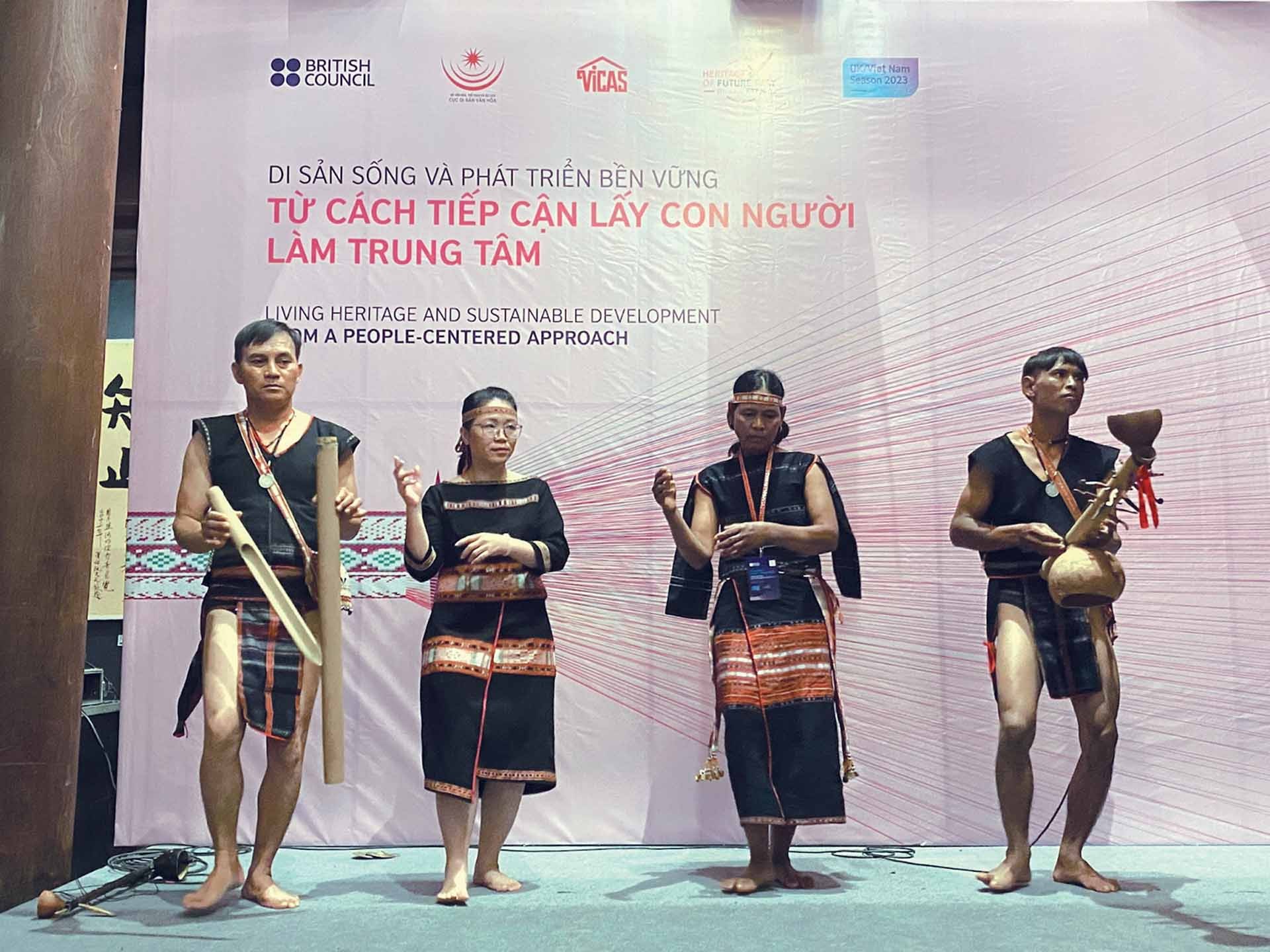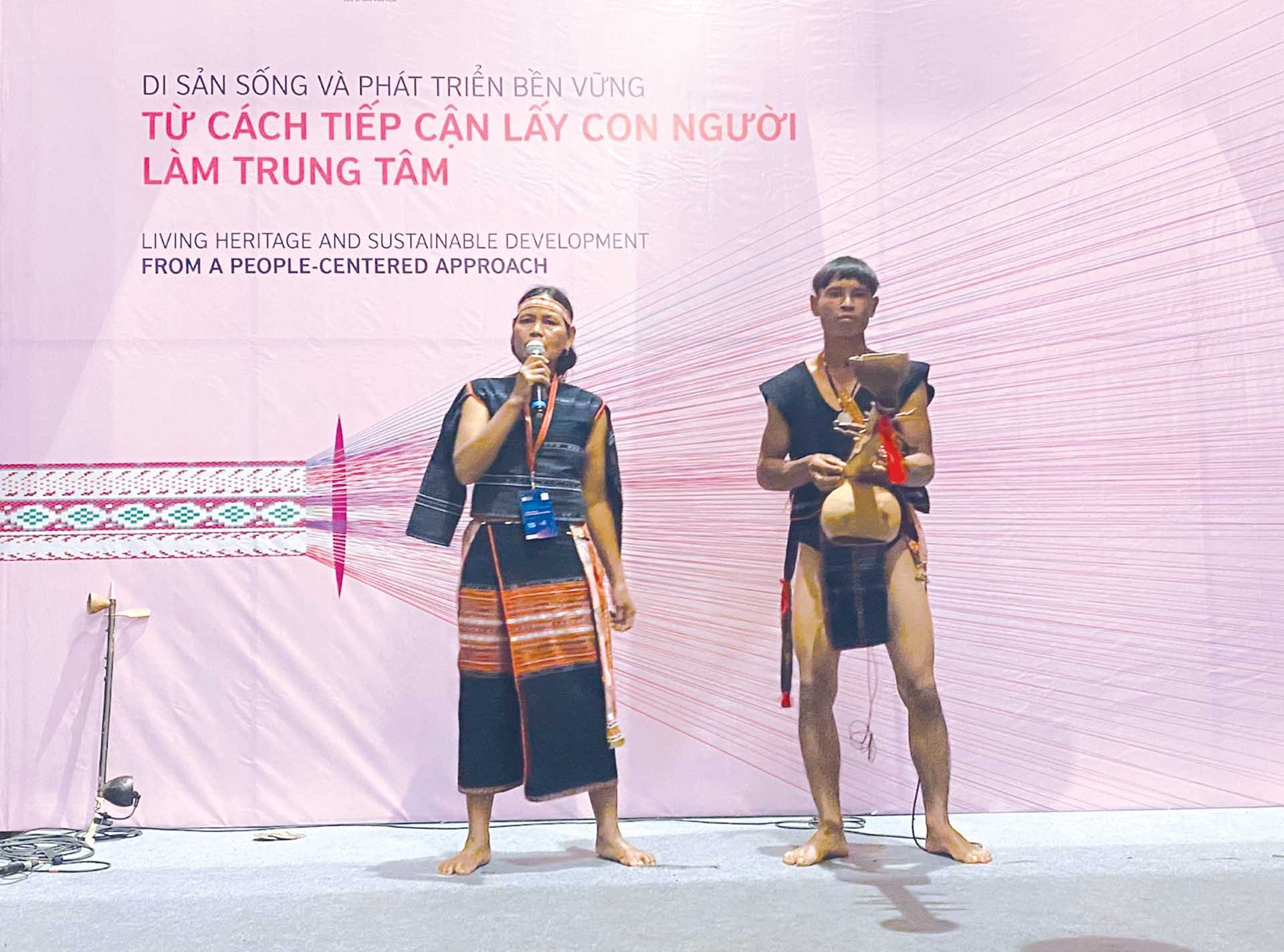
Unique musical heritage of Ba Na ethnic group
Latest
 |
| Artisans perform with traditional Bana musical instruments. (Photo: Phuong Thao) |
Recently, the Thai Hoc House of the special national relic site of Temple of Literature Hanoi attracted many tourists to enjoy Ba Na music - a meaningful activity coordinated by the British Council and the Vietnam Institute of Culture and Arts Studies (VICAS).
In the music space of the Ba Na people, the most typical artisans of Mo Hra village, Kong Long Khong commune, Kbang district, Gia Lai province have brought love stories, scenes of hard-working life but full of excitement and bright hope for a prosperous and fulfilling life.
Music is in the head, dance is in the body
In daily living habits, wooden floors, campfire, and rice wine are indispensable things of the Ba Na people. While they enjoy slow drinking, they begin to play the K'ni, sing, and sway to the music, and then when there is no one else to drink with, they lay there all night with the sounds still echoing.
Ba Na people's music often expresses the love between a couple, but in love, one night together is too short, so the song “Troi sang qua nhanh” ("It's bright too fast" in English) was born with Ting Ning (also known as goong, a traditional musical instrument of the Ba Na people) performed by artist Dinh Van Minh.
The Ba Na people follow matrilineality, so the love lyrics in the songs are often actively expressed by the Ba Na women to the men in the village.
Starting from the working life, the song “Khai thac muong ray” (“Do rice fields” in English) talks about the difficulties in the first crop, the budding love at this time urges the girl to express her feelings: "This time you go to the fields, do the farming, cut down trees to make shelters, I feel sorry for you very much."
And when she loves him, the girl sings to confess her love and offers to marry him: "I fall in love with you, let's come together, let's love each and take care of our children”.
Then when the boy agrees to that love, the girl continues singing with a bright smile on her lips.
While singing those sweet melodies, the Ba Na people dance rhythmically according to their unique Tay Nguyen Xoang dance. One step forward, two steps back, when the fire flared up and hands clasped, forming a large circle, all Ba Na people jumped together.
It is unclear where it started and when it was formed, but that music and dance have permeated the spiritual life of the Ba Na people.
People only know that the Ba Na ethnic group has a story about their grandparents getting married "husband is 45 years old, wife is 32 years old and they give birth to a child, then composing that song, then passing it on to their descendants. Some songs are up to 100 years old.”
During a performance in Hanoi, artisan Dinh Van Minh shared that every time the old people in the village invited him to sit with them, he would play music, they would sing, and then he would learn from them: "I always keep it in my head, then I come back home and sing the whole song again, I will perform it on special occasions."
Whether performing inside or outside the village, these tunes remain in his mind: "The music is in my head, the dance is in my body, it's the same at any location, there's no difference."
 |
| Artisan Dinh Thi Menh and artisan Dinh Van Minh perform the song "Khai thac muong ray". (Photo: Phuong Thao) |
“If you want to keep it, you must let it live”
Each melody and lyrics with rustic, traditional instruments such as the K'ni, Ting Ning, and bamboo pipes... are kept by the Ba Na people especially.
They are not recorded as musical notes on paper but through daily activities of the village such as worshiping occasions, holidays, and new rice festivals...
The children grow up surrounded by melodious sounds of songs, musical instruments, and dances. Then they begin to imitate, dance, and sing along. The sound of the musical instruments and the dances gradually permeate the children and when they reach adulthood, they know how to perform on their own.
The Ba Na people live in a rather hidden location in the district and live in village communities, with little contact with outside society. Therefore, cultural values and customs remain almost intact, unaffected by foreign cultures.
More importantly, the Ba Na people are very respectful and conscious of preserving their traditional values.
Not only preserving, but the Ba Na people also constantly promote those cultural values by composing new songs, mobilizing people to go to school, and then returning to pass them on to their children to enrich their cultural treasure. For example, “Bai ca tho cam” (Song about brocade) is sung in the daily brocade weaving activities of the Ba Na women; “Bai ca giao thong” (Traffic songs) encourages people to obey traffic laws.
Most people sing the songs “On Dang Nha nuoc” (Thank the Party and the Government) “Mung dat nuoc giai phong” (Celebrate the Liberation of the Country), “Mung Dang mung Xuan” (Celebrate the Party and Celebrate Spring), and many other songs to celebrate the country's great festivals.
Musical instruments have also been improved to represent different genres of music and songs. According to Mr. Minh, the Ting Ning used to have only one string, but now it has up to 13 strings or 18 strings.
The local government in Kbang district currently has many activities to support people in preserving and developing current cultural values.
Mr. Dinh Dinh Chi, Head of the Department of Culture and Information of Kbang district, Gia Lai province, shared: "When organizing certain programs and events, local authorities always spend the first 30-minute entertainment program for the Ba Na people’s dancing and singing performances".
Ba Na music has also been included in extracurricular activities in the school. Currently, almost all people in the village know how to play gongs, and there are 24 recognized artisans in the village.
Mr. Chi emphasized: "The most important thing to preserve Ba Na folk songs with strong national influences is the performance environment. If you want to keep it, you must let it live, make it associated with life, from spiritual life to living, accommodation... you must create music associated with life, rituals, and festivals so the children can inherit and live in that environment and let Ba Na music penetrate them naturally."
Mr. Odessa from Ukraine could not hide his joy of becoming one of the people experiencing this culture: "This is an interesting experience and the second time I have been conquered by this traditional melody. I knew that Bana music is performed at village communal houses. Where they live and the connection between spirituality and nature of this traditional music is very interesting".
During the final song, the audience at the Temple of Literature was invited on stage to participate in dancing. They held hands and danced the Central Highlands Xoang dance rhythmically to the music, without discrimination of age, skin color, or ethnicity. Everything blends into the melodious melody of the Tinh Ning and K'ni instruments…

















